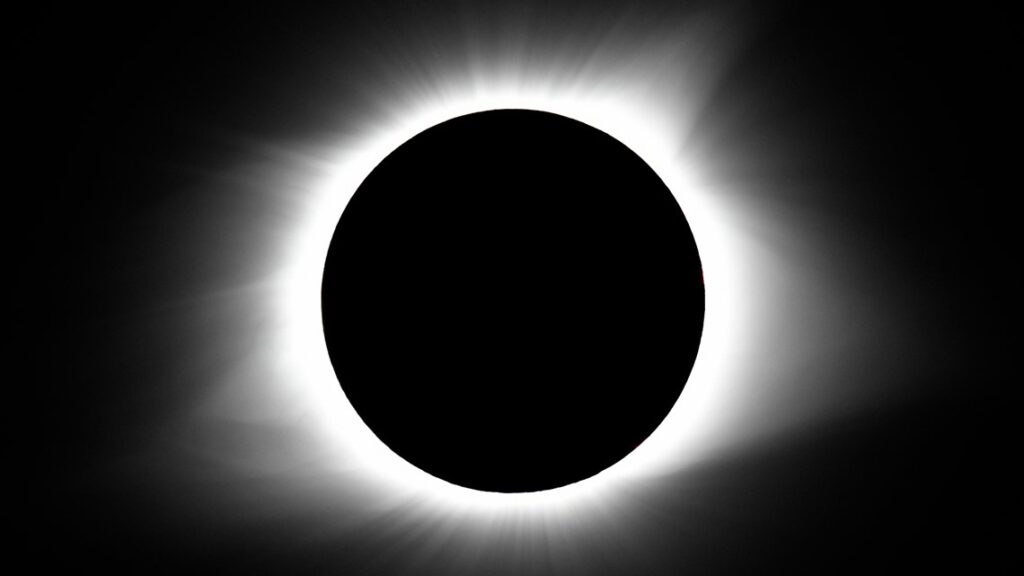The world is gearing up for an extraordinary event—the total solar eclipse (darkness) set to take place from April 8 to 10, 2024. Many anticipate that this cosmic phenomenon will herald the arrival of a Golden Age.
What is a total solar eclipse?
It occurs when the moon passes between the sun and the Earth, obscuring the sun’s light. According to NASA, these events happen approximately once every 18 months somewhere in the world. However, this upcoming eclipse is particularly noteworthy.
During a total solar eclipse, the moon completely covers the sun, plunging parts of the Earth into darkness.
Total solar eclipse (Darkness) from April 8 to 10, 2024 to be experienced
This rare celestial occurrence, known as the Great American Eclipse, is slated to take place from April 8, 2024.
In some regions, there are expectations of experiencing three days of darkness as the Earth traverses the Phonton Belt. Throughout this period, the planet will receive both sunlight and moonlight.
Photons, electromagnetic particles that travel at the speed of light, play a crucial role in this phenomenon. They obstruct the sun’s rays, preventing sunlight, moonlight, and starlight from reaching the Earth’s surface.
The total solar eclipse, dubbed the Great American Eclipse, is anticipated to last for three days, although some sources suggest it could extend up to five days.
During this period, the Earth will be shrouded in darkness for a duration of 72 hours or more, resembling an extended nighttime.
Individuals residing in areas where the Great American Eclipse will occur have been advised to prepare by stocking up on essential supplies such as food, candles, and water, and minimizing travel.
Those reliant on solar energy will face limitations in generating power during the eclipse, which commences on April 8th.
As per updates from the National Aeronautics and Space Administration (NASA), the total solar eclipse is scheduled to take place on April 8th, primarily affecting parts of Canada, Mexico, and the United States. Within the US, 14 states are set to experience a total solar eclipse, with residents in Texas, Oklahoma, Arkansas, Tennessee, Illinois, Kentucky, Indiana, Missouri, Ohio, Pennsylvania, New York, Vermont, New Hampshire, and Maine advised to prepare accordingly for this extraordinary event.
5 reasons why the 2024 total solar eclipse could be the best eclipse for hundreds of years
The total solar eclipses from April 8th to 10th, 2024, will mark the longest U.S. total solar eclipse since 1806, promising an awe-inspiring spectacle.
This event coincides with the solar maximum, ensuring a breathtaking display.
Anticipated to be the darkest U.S. total solar eclipse in 217 years, it may also offer the rare chance to witness a comet during totality.
With an estimated audience of at least 40 million viewers, it is poised to become the most-watched total solar eclipse in North American history.
What time will the total solar eclipse (darkness) be experienced on April 8?
NASA has announced that on April 8th, the South Pacific Ocean will be the point of start, while in North America, a total eclipse will be experienced on Mexico’s Pacific Coast around 11:07 a.m. PDT.
However, your location will depend on the time you experience a total eclipse of the sun.
Per the NASA update, these are the times they will experience total darkness.
Dallas at 1:40 p.m. CDT.
Little Rock at 1:51 p.m. CDT.
Carbondale, Kentucky – 1:59 p.m. CDT.
Cleveland at 3:13 p.m. EDT.
Buffalo, New York, at 3:18 p.m. EDT.
Caribou, Maine, at 3:32 p.m. EDT.
What you need to do to watch the April 8th total solar eclipse safely
Children and adults need special sunglasses made with solar filters. These glasses are also known as eclipse glasses or solar glasses.
How to view the eclipse safely
Once the sun’s rays reach the earth, you are not to use your naked eye to see since that can damage your eyes. You must therefore put on your sunglasses if you are to safely view the partial eclipse until the total eclipse.
Once there are full solar eclipses, you can remove your sunglasses and view the heavenly occurance with your eyes.
Your solar glasses must be put on again once the full solar eclipse changes to a partial eclipse.
If your country is not in the path of totality, you are likely to experience a partial eclipse.
There are several expected ecological reactions, and interesting things to watch out for are how animals of all kinds, including insects, react to the changes. Again, watch out for the cocks as the crowl thinking it’s night or dawn as the full eclipse occurs.
Look out for the street lights that will come alive once the total eclipse occurs.
After the Great American Eclipse in April, the next one will take place in August 2044 in the US.
NOTE:
PDT (Pacific Daylight Time)
CDT (Central Daylight Time)
EDT (Eastern Daylight Time)
Credit: Zambian Observer.


